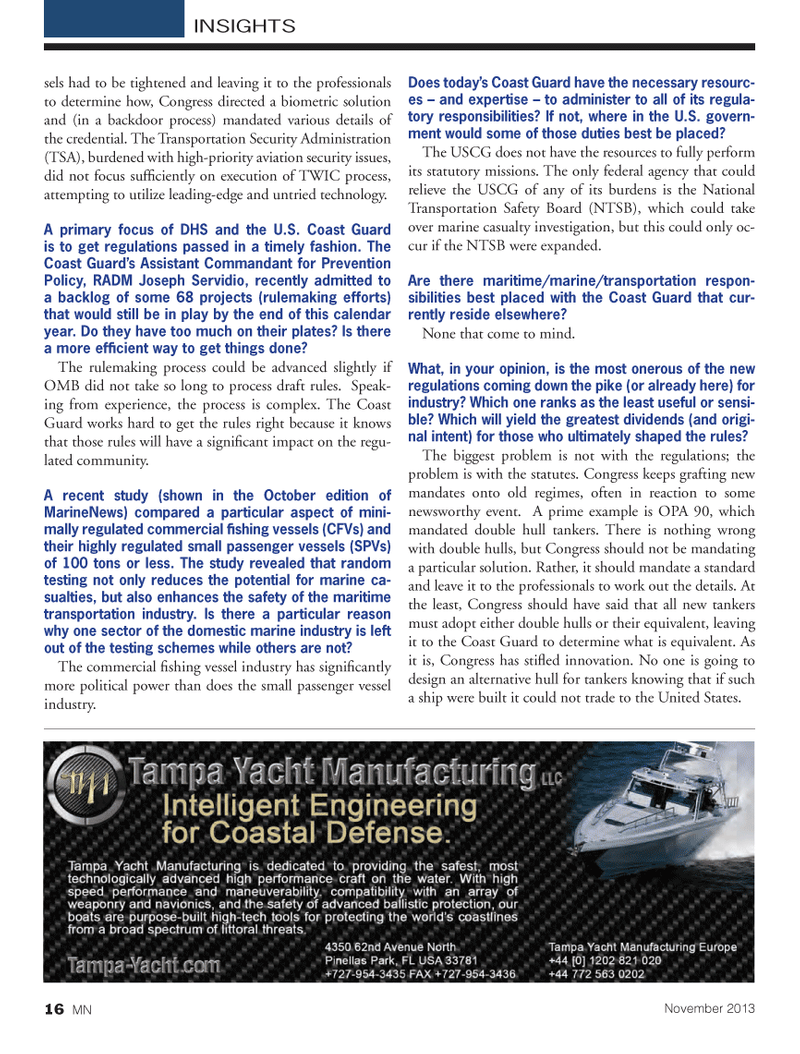
Page 16: of Marine News Magazine (November 2013)
Fleet Optimization Roundtable
Read this page in Pdf, Flash or Html5 edition of November 2013 Marine News Magazine
INSIGHTSsels had to be tightened and leaving it to the professionals to determine how, Congress directed a biometric solution and (in a backdoor process) mandated various details of the credential. The Transportation Security Administration (TSA), burdened with high-priority aviation security issues, did not focus sufÞ ciently on execution of TWIC process, attempting to utilize leading-edge and untried technology. A primary focus of DHS and the U.S. Coast Guard is to get regulations passed in a timely fashion. The Coast Guard?s Assistant Commandant for Prevention Policy, RADM Joseph Servidio, recently admitted to a backlog of some 68 projects (rulemaking efforts) that would still be in play by the end of this calendar year. Do they have too much on their plates? Is there a more ef cient way to get things done? The rulemaking process could be advanced slightly if OMB did not take so long to process draft rules. Speak- ing from experience, the process is complex. The Coast Guard works hard to get the rules right because it knows that those rules will have a signiÞ cant impact on the regu- lated community. A recent study (shown in the October edition of MarineNews) compared a particular aspect of mini- mally regulated commercial shing vessels (CFVs) and their highly regulated small passenger vessels (SPVs) of 100 tons or less. The study revealed that random testing not only reduces the potential for marine ca- sualties, but also enhances the safety of the maritime transportation industry. Is there a particular reason why one sector of the domestic marine industry is left out of the testing schemes while others are not? The commercial Þ shing vessel industry has signiÞ cantly more political power than does the small passenger vessel industry. Does today?s Coast Guard have the necessary resourc- es ? and expertise ? to administer to all of its regula- tory responsibilities? If not, where in the U.S. govern- ment would some of those duties best be placed?The USCG does not have the resources to fully perform its statutory missions. The only federal agency that could relieve the USCG of any of its burdens is the National Transportation Safety Board (NTSB), which could take over marine casualty investigation, but this could only oc- cur if the NTSB were expanded. Are there maritime/marine/transportation respon- sibilities best placed with the Coast Guard that cur- rently reside elsewhere? None that come to mind. What, in your opinion, is the most onerous of the new regulations coming down the pike (or already here) for industry? Which one ranks as the least useful or sensi-ble? Which will yield the greatest dividends (and origi- nal intent) for those who ultimately shaped the rules?The biggest problem is not with the regulations; the problem is with the statutes. Congress keeps grafting new mandates onto old regimes, often in reaction to some newsworthy event. A prime example is OPA 90, which mandated double hull tankers. There is nothing wrong with double hulls, but Congress should not be mandating a particular solution. Rather, it should mandate a standard and leave it to the professionals to work out the details. At the least, Congress should have said that all new tankers must adopt either double hulls or their equivalent, leaving it to the Coast Guard to determine what is equivalent. As it is, Congress has stiß ed innovation. No one is going to design an alternative hull for tankers knowing that if such a ship were built it could not trade to the United States. November 201316 MNMN November2013 Layout 1-17.indd 16MN November2013 Layout 1-17.indd 1610/28/2013 3:12:34 PM10/28/2013 3:12:34 PM

 15
15

 17
17
